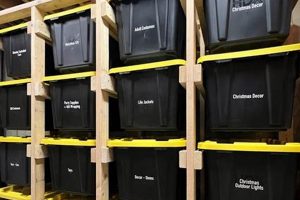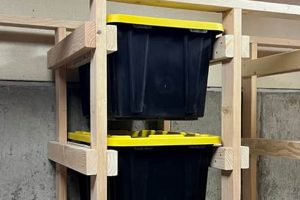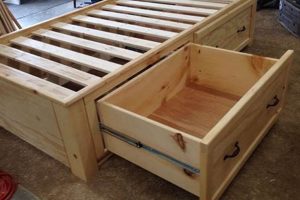Construction of a customized system designed to hold kayaks, often in a garage, shed, or outdoors, and typically built by the individual user rather than purchased pre-made. An example is building a wall-mounted rack from lumber and straps to store kayaks horizontally. This approach allows for tailored dimensions and features to suit specific needs and available space.
Properly configured storage extends the lifespan of kayaks by preventing damage from improper support, exposure to the elements, and accidental impact. Utilizing self-constructed solutions provides a cost-effective alternative to commercial options and allows users to optimize space usage. Historically, individuals have adapted available materials and techniques to create functional and personalized storage solutions.
The subsequent discussion will detail various construction methods, material selection considerations, and design principles relevant to creating durable and efficient kayak storage solutions. Key factors in achieving a successful outcome include understanding load-bearing capacity, environmental protection, and ergonomic accessibility.
Essential Considerations for Building Kayak Storage
Constructing a kayak storage structure requires careful planning and execution. The following points provide guidance to ensure a safe and effective build.
Tip 1: Material Selection: Prioritize weather-resistant materials. For outdoor racks, treated lumber or composite materials resist rot and insect damage. Indoor racks can utilize untreated lumber, but consider a sealant for moisture protection.
Tip 2: Weight Capacity Calculation: Accurately determine the weight of each kayak to be stored. Over-engineering the rack’s load-bearing capacity provides a safety margin and ensures long-term stability. Consult load tables for lumber specifications.
Tip 3: Support Surface Considerations: Ensure kayaks are supported along their widest points to prevent hull deformation. Utilize padded cradles or wide straps to distribute weight evenly and avoid pressure points. Avoid point loads.
Tip 4: Mounting Hardware: Employ appropriate fasteners for the chosen mounting surface. Lag screws into wall studs offer superior holding power for wall-mounted racks. Galvanized hardware resists corrosion in outdoor environments.
Tip 5: Space Optimization: Consider vertical storage to maximize available space. Overhead racks or hoist systems allow for storage above vehicles or other equipment. Measure available ceiling height before construction.
Tip 6: UV Protection: Prolonged exposure to sunlight degrades kayak materials. Locate racks in shaded areas or utilize protective covers to minimize UV damage. Consider painting or staining the rack for added UV resistance.
Tip 7: Secure Kayak Attachment: Implement a reliable method for securing kayaks to the rack to prevent accidental falls. Straps with buckles or bungee cords provide secure and easily adjustable attachment points.
These considerations will ensure the construction of a robust and reliable kayak storage solution, protecting the watercraft and maximizing space efficiency.
The final section will summarize essential safety practices applicable when utilizing and maintaining the completed storage solution.
1. Material Durability
Material durability is a paramount consideration in “kayak rack storage diy” projects. The chosen materials directly influence the lifespan of the rack, its ability to withstand environmental factors, and its capacity to protect stored kayaks from damage. Selection must balance cost-effectiveness with long-term performance.
- Resistance to Environmental Degradation
Materials used in outdoor kayak rack storage solutions are exposed to varying degrees of moisture, sunlight, and temperature fluctuations. Untreated wood is susceptible to rot, warping, and insect infestation. Metals may corrode. Therefore, selecting pressure-treated lumber, composite materials, or corrosion-resistant metals is essential. For instance, using galvanized steel hardware instead of standard steel significantly reduces the risk of rust in coastal environments, extending the rack’s usability. Similarly, UV-resistant coatings on wooden racks prevent fading and cracking caused by prolonged sun exposure.
- Structural Integrity Under Load
The rack’s ability to support the weight of the kayaks without deformation or failure hinges on the material’s inherent strength and rigidity. Softwoods, while cost-effective, may lack the necessary load-bearing capacity for multiple or heavy kayaks. Hardwoods or reinforced steel offer superior strength and stability. An example is using 2×6 lumber instead of 2×4 for the support arms of a wall-mounted rack, increasing its weight capacity. Careful calculation of load requirements is crucial when selecting materials.
- Resistance to Wear and Abrasion
Contact between the kayak and the rack can lead to abrasion and wear on both surfaces. Using materials with smooth finishes and rounded edges minimizes the risk of damage to the kayak’s hull. Applying padding or protective coatings to the rack’s contact points further reduces friction. For example, wrapping the support arms with closed-cell foam protects the kayak from scratches and dents. Similarly, using a durable paint or sealant on wooden racks creates a protective barrier against abrasion.
- Long-Term Cost-Effectiveness
While lower-cost materials may seem appealing initially, their shorter lifespan can lead to higher replacement or repair costs in the long run. Investing in durable materials upfront can prove more cost-effective over time. For instance, constructing a rack from recycled plastic lumber may have a higher initial cost than using untreated pine, but its resistance to rot and insect damage eliminates the need for frequent replacement. The total cost of ownership, including maintenance and potential repairs, should be considered when evaluating material options.
In summary, the selection of durable materials is fundamental to the success of any “kayak rack storage diy” project. By considering factors such as environmental resistance, structural integrity, abrasion resistance, and long-term cost-effectiveness, builders can create storage solutions that protect their kayaks and provide years of reliable service. The trade-offs between initial cost and long-term durability should be carefully weighed to optimize the investment.
2. Load distribution
In “kayak rack storage diy,” proper load distribution is a critical factor directly affecting the structural integrity of the rack and the longevity of the stored kayaks. Insufficient attention to load distribution leads to concentrated stress points, increasing the risk of rack failure and potential damage to the kayak hulls. The principle dictates that the weight of the kayak must be evenly spread across the supporting structure to minimize stress on any single point. A real-life example of improper load distribution is a rack with narrow support arms spaced too far apart. This scenario causes the kayak’s hull to sag between the supports, potentially leading to deformation over time. In contrast, a rack with wide, padded supports that closely conform to the hull shape distributes the weight effectively, preventing localized stress.
Practical applications of understanding load distribution principles manifest in several design choices. The selection of support arm material and dimensions is crucial. For instance, a rack designed to hold a heavy tandem kayak necessitates stronger and wider support arms than a rack intended for a lightweight recreational kayak. The spacing between support arms must also be carefully considered. As the distance between supports increases, the bending moment on the hull intensifies, requiring a more robust support structure. The implementation of hull cradles, shaped to match the kayak’s contours, further enhances load distribution by providing a larger contact area and preventing pressure points. These cradles may be fabricated from wood, foam, or other resilient materials.
Effective load distribution in kayak rack storage represents a significant engineering challenge within the “kayak rack storage diy” context. Achieving optimal load distribution necessitates a comprehensive understanding of structural mechanics, material properties, and kayak hull geometry. While complete adherence to engineering principles may not be feasible for all DIYers, adopting a cautious approach, erring on the side of over-engineering, and thoroughly testing the rack before long-term use are prudent practices. The ultimate goal is to create a storage solution that safely and securely supports the kayak, preserving its performance and value for years to come. Addressing the challenge of load distribution is paramount to a successful build.
3. Space efficiency
Effective spatial utilization stands as a primary driver in many “kayak rack storage diy” projects. The availability of storage area often dictates the design and implementation of such solutions. Limitations in garage size, shed capacity, or even outdoor footprint necessitate designs that maximize kayak storage while minimizing encroachment on usable space. This frequently leads to the adoption of vertical storage solutions, such as wall-mounted racks or overhead hoist systems, which leverage otherwise unused airspace. The practical significance lies in preserving functional areas for parking vehicles, storing other equipment, or maintaining clear pathways. A cluttered storage area creates hazards and reduces usability. Therefore, achieving space efficiency directly correlates to an increase in overall utility and safety.
The application of space-efficient designs manifests in diverse forms. Foldable or collapsible rack systems, for example, provide temporary storage solutions that can be stowed away when not in use. Utilizing the vertical dimensions of a garage or shed with multi-tiered racks allows for the storage of multiple kayaks in a minimal footprint. Furthermore, integrating storage with existing structural elements, such as utilizing the space beneath staircases or between rafters, offers creative approaches to spatial optimization. A crucial element in achieving this is precise measurement and careful planning to ensure that the chosen design effectively integrates into the available space without compromising accessibility or safety. The cause and effect relationship is direct: limited space demands inventive and compact storage solutions.
In summary, the pursuit of space efficiency forms an integral component of “kayak rack storage diy.” Challenges arise in balancing storage capacity with ease of access and structural stability. The ability to effectively utilize available space transforms a potentially cluttered and hazardous environment into an organized and functional one. The design process must prioritize spatial constraints to deliver a tailored solution that enhances both the storage capacity and the overall usability of the designated area. Prioritizing this will promote successful project outcomes and overall convenience.
4. Weather resistance
Weather resistance is a critical design consideration in the context of “kayak rack storage diy,” particularly for systems intended for outdoor deployment. The ability of a rack to withstand environmental stressors directly impacts its longevity, structural integrity, and the degree of protection afforded to the stored kayaks. The inherent properties of selected materials and the application of protective finishes are paramount.
- Material Selection: Resistance to Moisture and Rot
Untreated wood is susceptible to decay when exposed to moisture, rendering it unsuitable for outdoor racks. Pressure-treated lumber, composite materials, or naturally rot-resistant species like cedar offer superior protection against fungal degradation and insect infestation. For example, a rack constructed from pressure-treated pine will endure significantly longer than one made from untreated pine in a humid climate. The selection should account for regional climate conditions and expected exposure levels.
- Corrosion Resistance of Metallic Components
Metallic fasteners and structural elements are vulnerable to corrosion, particularly in coastal environments or regions with high levels of acid rain. Galvanized steel, stainless steel, or aluminum offer enhanced resistance to oxidation and degradation. Substituting standard steel bolts with stainless steel alternatives in a rack designed for beachfront storage significantly reduces the risk of structural failure due to rust. Regular inspection and maintenance are still advisable, even with corrosion-resistant materials.
- UV Protection and Degradation Prevention
Prolonged exposure to ultraviolet (UV) radiation can degrade polymers and weaken wood. Application of UV-resistant coatings, paints, or stains provides a protective barrier against sun damage. A dark-colored stain on a wooden rack, while aesthetically pleasing, may absorb more heat and accelerate degradation compared to a lighter-colored, reflective coating. UV-resistant fabric covers can also protect kayaks from direct sunlight exposure.
- Wind Resistance and Structural Stability
Outdoor kayak racks must withstand wind loads, which can exert significant force on both the rack structure and the stored kayaks. Design considerations should include a low profile, secure anchoring, and appropriate bracing to prevent tipping or collapse. A rack built with wide, stable feet and securely anchored to a concrete pad will better resist high winds compared to a lightweight, freestanding structure. Local building codes may dictate specific wind load requirements.
The facets of weather resistance are interconnected and collectively determine the long-term performance of a “kayak rack storage diy” solution. Careful consideration of material properties, protective coatings, and structural design is essential to ensure the rack can withstand environmental challenges and provide reliable kayak storage for years to come. Ignoring these factors compromises the investment in both the rack itself and the kayaks it is intended to protect.
5. Secure mounting
Secure mounting is a non-negotiable prerequisite for any viable “kayak rack storage diy” endeavor. The correlation between secure mounting and the overall success of a DIY kayak rack is direct and consequential: a failure in the mounting system precipitates a potential collapse of the entire structure, resulting in damage to the watercraft, the surrounding environment, and potentially causing physical injury. Secure mounting necessitates a thorough understanding of the underlying structural support, the weight-bearing capacity of the mounting hardware, and the forces exerted on the system by the kayaks themselves. An example of insufficient secure mounting is a wall-mounted rack installed with inadequate fasteners into drywall alone, rather than directly into wall studs. The consequence is inevitable: the rack will detach from the wall under the weight of the kayaks. The practical significance of understanding this relationship is the prevention of catastrophic failure and the assurance of long-term stability.
Further analysis reveals the multifaceted nature of secure mounting. The selection of appropriate fasteners is crucial. Lag screws, carriage bolts, and expansion anchors each offer different levels of holding power and are suited for different substrates, such as wood, concrete, or metal. The depth and diameter of the fastener must be carefully matched to the load requirements and the substrate material. Proper installation techniques are equally important. Over-tightening can strip threads or weaken the substrate, while under-tightening can leave the fastener vulnerable to loosening over time. Furthermore, the orientation and spacing of mounting points influence the distribution of stress across the support structure. Placing mounting points closer together concentrates stress, while spacing them too far apart can create leverage points that compromise stability. Regular inspection of mounting hardware is also crucial to ensure the fasteners remain secure over time.
In summary, secure mounting represents a foundational element in “kayak rack storage diy.” Neglecting this aspect introduces unacceptable levels of risk. The challenge lies in accurately assessing load requirements, selecting appropriate mounting hardware, and employing proper installation techniques. Regular inspection and maintenance are necessary to ensure long-term stability. Successfully addressing these challenges leads to a safe and reliable storage solution that protects the investment in the kayaks and mitigates potential hazards. The implications of compromised secure mounting are extensive and warrant meticulous attention to detail throughout the design and implementation phases.
Frequently Asked Questions
The following addresses common inquiries regarding the construction and implementation of self-built kayak storage solutions.
Question 1: What is the most cost-effective material for building a kayak rack?
Pressure-treated lumber generally presents the most economical balance between cost and durability for outdoor applications. However, recycled materials or reclaimed lumber may offer lower initial costs, contingent upon availability and condition. For indoor racks, untreated lumber may suffice, reducing material expenses.
Question 2: How do I determine the appropriate load capacity for my DIY kayak rack?
Accurately weigh each kayak intended for storage. Consult load-bearing charts for the selected lumber species and dimensions. Over-engineer the rack by adding a safety factor of at least 25% to accommodate potential weight fluctuations or unforeseen stresses. Distribute the load evenly across multiple support points.
Question 3: What are the essential tools required for constructing a kayak rack?
Minimum tool requirements include a measuring tape, saw (circular or hand saw), drill with various bits, level, sandpaper, and appropriate safety gear (eye protection, gloves). A power screwdriver or impact driver simplifies fastener installation. Clamps are useful for securing pieces during assembly.
Question 4: How can I protect my kayaks from damage while stored on a DIY rack?
Pad all contact points between the kayak and the rack using closed-cell foam, carpet remnants, or similar materials. Ensure the support surfaces are smooth and free of sharp edges or protrusions. Regularly inspect the rack for any signs of wear or damage that could compromise kayak safety.
Question 5: What are the key considerations for mounting a wall-mounted kayak rack?
Locate and mark wall studs accurately. Utilize lag screws of sufficient length to penetrate deeply into the studs. Ensure the rack is level and plumb. Avoid mounting solely to drywall, as it lacks the necessary load-bearing capacity. Consider the height of the rack to ensure ease of access without compromising headroom.
Question 6: How can I minimize the space required for kayak storage?
Vertical storage solutions, such as wall-mounted racks or overhead hoist systems, maximize available space. Consider folding or collapsible racks for temporary storage. Optimize the layout of the storage area to minimize wasted space around the rack.
Proper planning, material selection, and construction techniques are crucial for a safe and effective kayak rack storage solution. Prioritizing safety and durability ensures both the longevity of the rack and the protection of the stored watercraft.
The next segment discusses recommended maintenance practices for DIY kayak racks to ensure lasting performance and safety.
Conclusion
“Kayak rack storage diy” initiatives demand rigorous planning and execution. This exploration has highlighted essential considerations ranging from material durability and proper load distribution to space efficiency, weather resistance, and secure mounting. Each facet contributes significantly to the safety and longevity of both the storage solution and the watercraft it supports.
Prioritizing these elements facilitates the creation of customized, cost-effective storage solutions. Continued adherence to sound construction principles and regular maintenance protocols ensures the long-term reliability and effectiveness of “kayak rack storage diy” endeavors. Future innovations may focus on sustainable materials and further optimization of space-saving designs, reinforcing the importance of informed and conscientious craftsmanship.







![Build Your Own! Storage Bin Rack DIY Project [Easy] The DIY Hub: Creative Crafts, Repairs & Life Hacks Build Your Own! Storage Bin Rack DIY Project [Easy] | The DIY Hub: Creative Crafts, Repairs & Life Hacks](https://craftingdiycenter.com/wp-content/uploads/2025/07/th-1825-300x200.jpg)